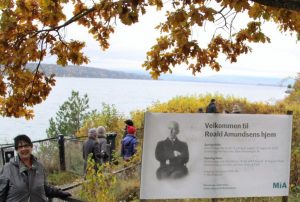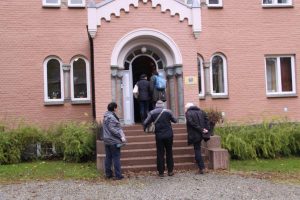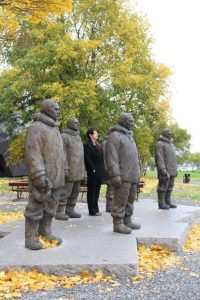Feature photograph: ALSA’s archivist, Ria Olivier alongside a statue of polar explorer Roald Amundsen outside the Fram Museum on Bygdøy, Oslo
The Polar Museums Network (PMN) has been created for all countries and individuals that house exhibitions of polar material. The PMN is an initiative to strengthen and spread knowledge of polar history, science and exploration. The network held its inaugural Conference at the Fram Museum in Oslo, Norway last month with the Antarctic Legacy of South Africa in attendance (click here)
ALSA was contacted by the conference organisers to ask if it would give a presentation on South African Antarctic museums. Unfortunately, there is no museum solely dedicated to South Africa’s Antarctic and the sub-Antarctic Island heritage in the country. This led to the question what could ALSA do to help create such a museum?
The first point to consider is what is the function of a museum? According to the International Council of Museums’ (ICOM) Statutes, adopted by its 22nd General Assembly in Vienna, Austria on 24 August 2007:
“A museum is a non-profit, permanent institution in the service of society and its development, open to the public, which acquires, conserves, researches, communicates and exhibits the tangible and intangible heritage of humanity and its environment for the purposes of education, study and enjoyment.”
Taking this definition into account I realised that ALSA has a definite responsibility in this regard. The theme of the conference in Oslo was Polar Partnerships: Working together to spread the knowledge of polar history, science and exploration. My presentation put forward a question:
“How important is it for South Africa as the only country on the continent involved in Antarctica to establish a dedicated museum for its future generations?”
The demographics of South Africa encompass about 53 million people of diverse origins, cultures, languages, and religions. The greater part of this population knows little about the Antarctic Continent and probably less of South Africa’s involvement since (and before) the days of the heroic age of polar exploration.

My presentation gave an insight into the huge task that would lay ahead to create a dedicated Antarctic museum in South Africa for future generations, starting with a description of what polar materials currently exist in the country. There are different options to explore, but perhaps the best site for a physical museum would be in Cape Town’s V&A Waterfront in the Table Bay Harbour from where many polar expeditions left for the south in the past – and still do. However, a physical museum at a single locality would not reach into the country’s rural areas. A digital museum is an easier option to follow initially and could bring material already available in digitised format in ALSA’s archives to schools and communities throughout the country.
At the Oslo conference I presented a prototype of a digital museum that could be created utilizing materials already in ALSA’s open-access archive (accessible via this web site). My presentation was well received and some of the curators present thought digital museums were a good option to extend the outreach of their own exhibitions.
My attendance was a great opportunity to learn from other participants and also to create awareness of South Africa’s Antarctic legacy on an international platform. ALSA is now part of the Polar Museums Network and aims to contribute to it (including by posting to its Facebook page) and gain knowledge from its members. The proceedings of the conference are expected to be published next year.
After the conference’s formal proceedings an enjoyable study tour included visits to Uranienborg, the home of Roald Amundsen, the Fridtjof Nansen Institute (based in the home of the Norwegian Arctic explorer Fridtjof Nansen) and the Ski Museum in and near Oslo.





The SPRI Polar Directory is hosted by the Scott Polar Research Institute in Cambridge, UK. South Africa is currently poorly represented in the directory so ALSA has made a start encouraging those institutions, including museums, in the country with polar materials or links to register (click here).
Thanks are due to the National Research Foundation for support towards ALSA’s attendance at the conference in Norway.
Ria Olivier, Archivist, Antarctic Legacy of South Africa, Department of Botany and Zoology, Stellenbosch University, 08 November 2016

